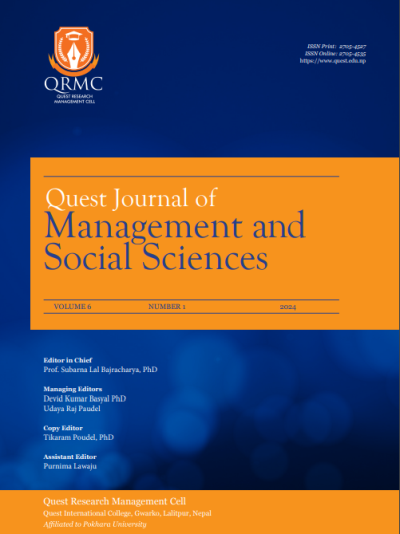Navigating the Impact of Foreign Aid: A Holistic View of Educational Aid Disbursements in Developing Nations
DOI:
https://doi.org/10.3126/qjmss.v6i1.67148Keywords:
Aid Effectiveness, Education Aid, Good Governance, Primary Level, Secondary LevelAbstract
Background: Foreign aid is a fundamental instrument of international cooperation, intended theoretically to ameliorate the disparities in saving-investment dynamics, knowledge acquisition, and foreign exchange within developing nations. Despite over half a century of endeavours to evaluate its efficacy, the ongoing discourse on whether aid engenders predominantly positive outcomes in recipient countries remains inconclusive. Consequently, the nuanced impact of foreign aid on addressing challenges in developing nations remains a topic necessitating comprehensive and rigorous analysis.
Objective: The primary aim of this study is to augment the existing body of knowledge within the domain of foreign aid by scrutinising the impact of education aid on improving educational achievements, particularly at the primary and secondary education tiers, by focusing on the overall, gender-wise, income level-wise, and donor-wise effect. This study focuses on delineating the influence of aid on the Primary Completion Rate (PCR), recognising its role as a precursor to shaping the Secondary School Level Net Enrollment Rate (SERNet).
Method: This study utilised recent data on education aid disbursements across 50 low—and lower-income countries over 19 years (2002-2020). It specifically examined the cross-sector effects of this aid within the education sector, focusing on its impact on both the PCR and the SERNet. The analysis was conducted using the two-stage least squares methodology using the instrumental variables (IV-2SLS).
Result: The findings revealed a statistically significant and positive correlation between education aid and the PCR, while no substantial relationship was observed with the SERNet. This discrepancy indicates that aid to improve primary school completion may not necessarily lead to enhancements in secondary school enrollments. Additionally, the analysis demonstrated that economic factors, governance, and school-related structural variables also play crucial roles in improving educational outcomes in developing countries.
Conclusion: These outcomes suggest that the efficacy of foreign aid exhibits variance across different scenarios. The challenges concerning PCR and SERNet likely diverge, implying that assessing aid impacts singularly might be inadequate. Tailoring an aid to address specific issues could yield more favourable outcomes.
Paper Type: Research Paper
Downloads
Downloads
Published
How to Cite
Issue
Section
License
Copyright (c) 2024 Quest Journal of Management and Social Sciences

This work is licensed under a Creative Commons Attribution-NonCommercial-NoDerivatives 4.0 International License.
This license enables reusers to copy and distribute the material in any medium or format in unadapted form only, for noncommercial purposes only, and only so long as attribution is given to the creator.




